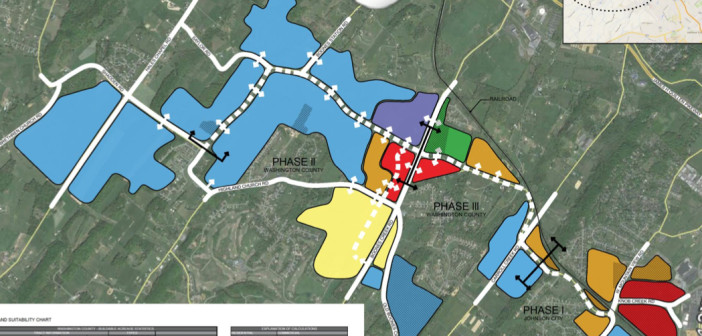By Jeff Keeling
Build it, and they will come. We’re pretty sure. It just may take awhile.
So says a consultant, whose study of development potential along Knob Creek Road north and west toward Gray is in. It projects property tax income outpacing the amount local governments would borrow for infrastructure over a 20-year period. Additional new revenue in the form of sales tax growth would be icing on the cake, representatives from Charlotte-based Kimley-Horn said.
The study was commissioned by the Washington County Economic Development Council (WCEDC) at a cost of $58,000. In a nutshell, the suggests that local governments would borrow roughly $80 million to provide roads, sewer, other infrastructure and a county school/park combination, and that residential and commercial property tax growth from development would begin offsetting borrowing costs for that money in the ninth year after “build out”begins.
The full study can be accessed here: FINAL_KnobCreek_Presentation20150319
“We wanted to show the difference between what you have today and what you could have in the future depending on if a road was built or a road was not built,” Kimley-Horn’s Jessica Rossi said at the WCEDC’s monthly meeting Thursday.
If a school and park were built, the study estimated property tax revenues ultimately would grow by roughly $5.4 million from their current annual levels, though that would take up to several decades. That would come from a mixture of single family homes, multi-family developments, retail and commercial growth, and it compares to an estimated increase of $1.6 million in property tax revenues were the road project, park and school not to be completed.
“We’ve taken a real conservative approach to all these numbers, so we felt comfortable that as we do the projected tax revenues that those would meet or exceed estimates,” Rossi said. She noted, for instance, they estimated an average single-family home price of $350,000, below the average for homes being built in that area of the county. One of her partners, David Coode, said the driving factor toward that growth would likely be the presence of a new school.
In partnership with local engineering firm Tysinger, Hampton & Partners, Kimley Horn spent several weeks creating a “Land Use Concept and Gross Revenue Forecast” for an area covering about 2,300 acres. The studied corridor starts at Knob Creek’s intersection with North State of Franklin Road and heads west northwest through a planned road widening and railroad tunnel project. It then continues through Knob Creek’s intersection with Boone Creek Road, and along Highland Church Road to Hales Chapel Road.
While the study accounted for infrastructure borrowing costs, Rossi said it did not take into account additional cost of public services such as police and fire protection that would be required to serve the area. It does note an estimated $2.8 million in additional annual sales tax revenues from retail activity – most of which is expected to develop near Johnson City and Boones Creek – at full build out.
When the study was approved in February, Washington County Mayor Dan Eldridge and Johnson City City Manager Pete Peterson both said future metro area growth is almost certain to be partly concentrated in this corridor if local governments invest in infrastructure.
The estimated totals, according to Kimley-Horn? Nearly 2,100 single-family homes, with peak development in years four through 10; another 1,529 multi-family units; 712,000 square feet of retail space, and 62,000 square feet of office space. A link to the study is available inside the online version of this story at jcnewsandneighbor.com/corridorstudy.




